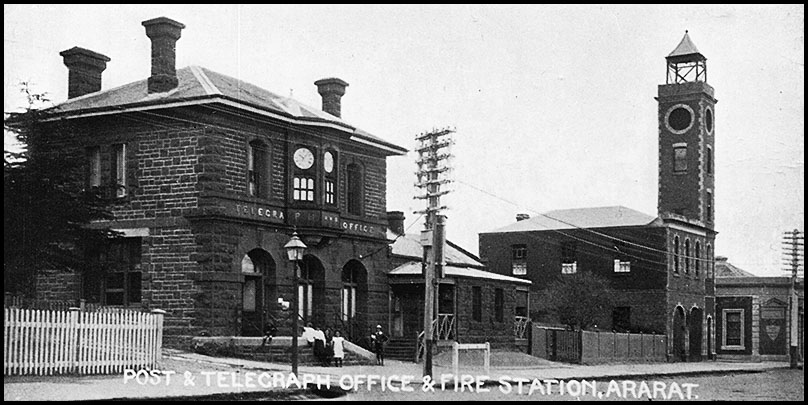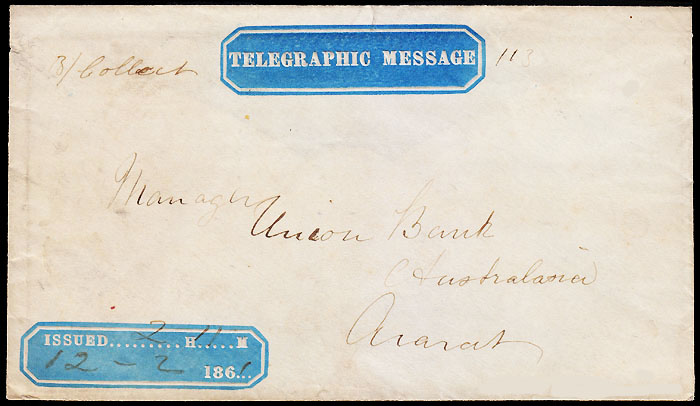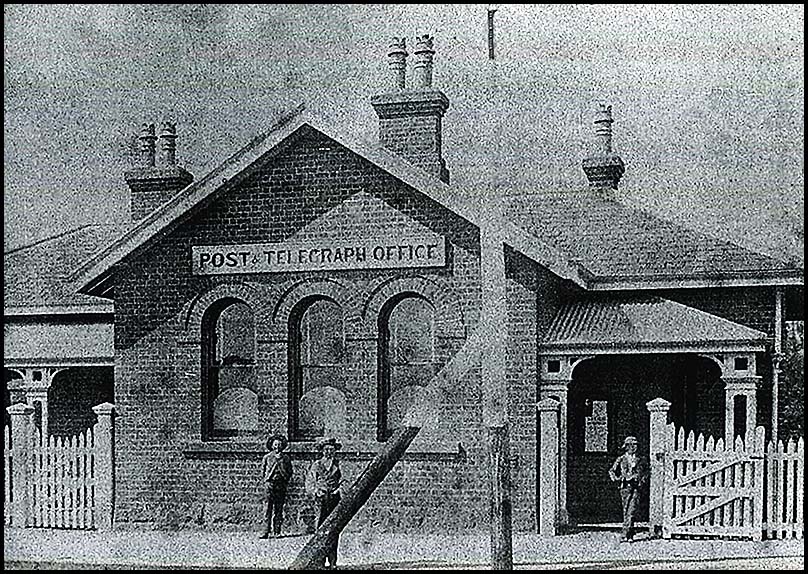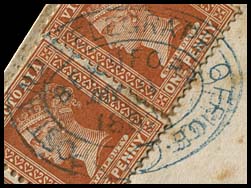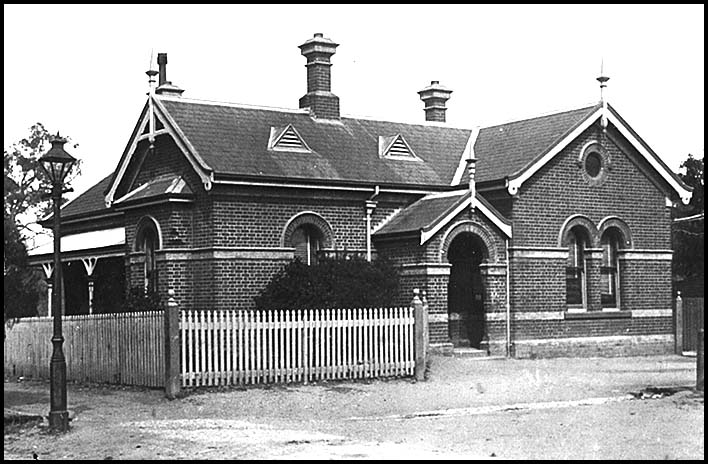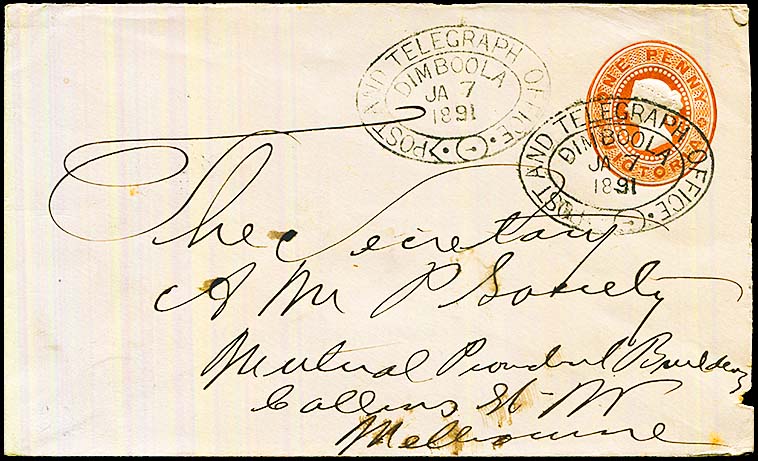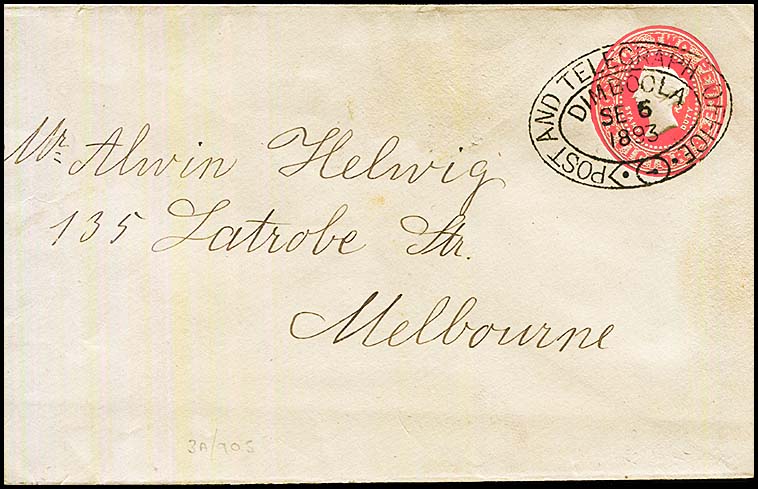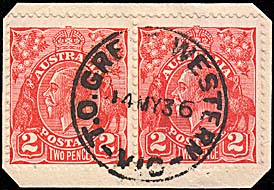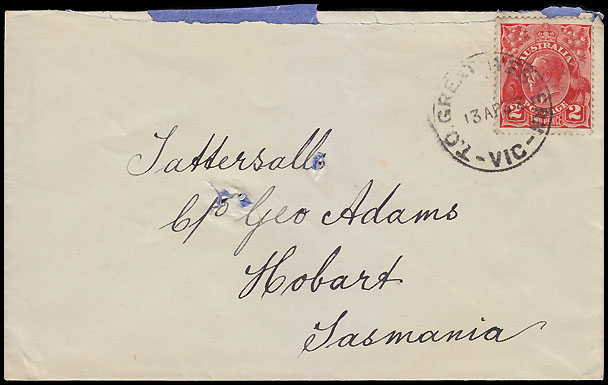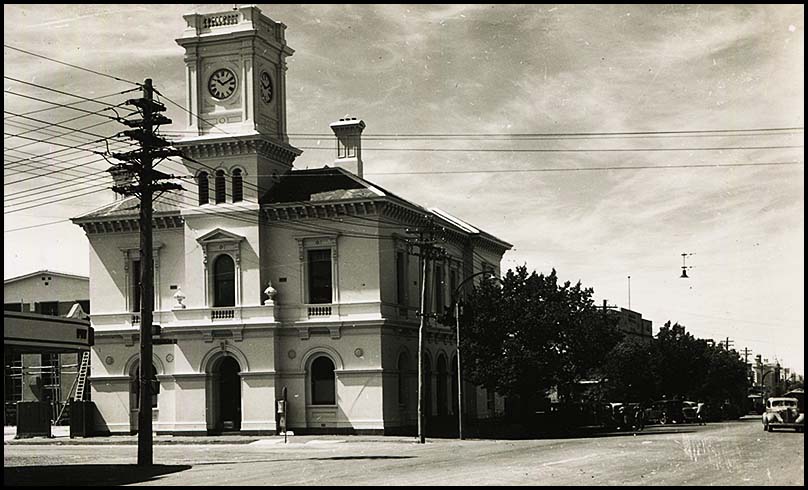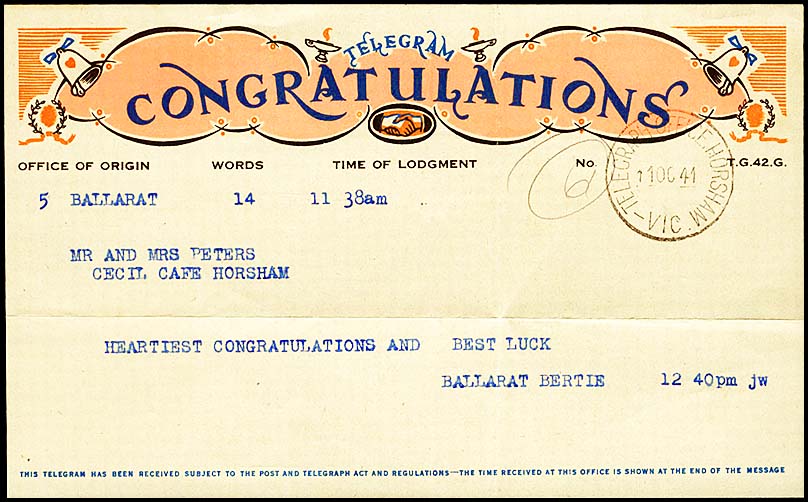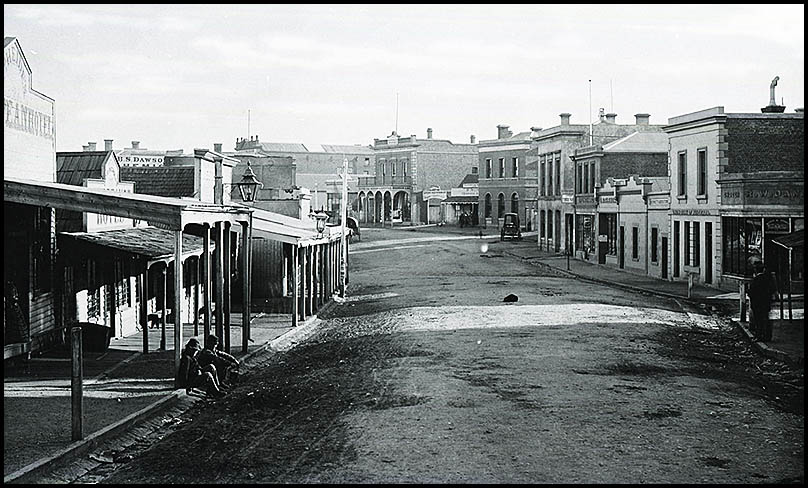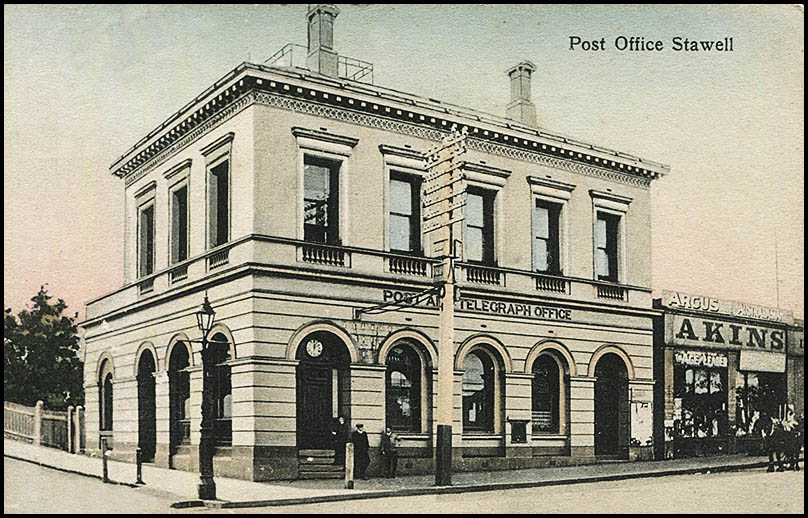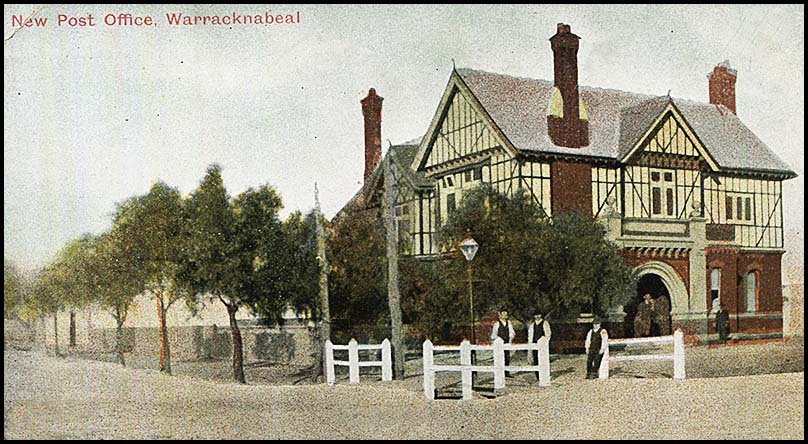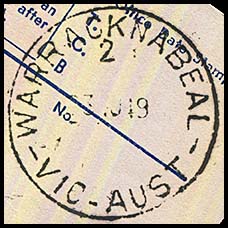Telegraph Offices on the Bordertown (No. 5 West) line.
- Australia 1901-1988
- New South Wales
- Queensland
- South Australia
- Tasmania
- Victoria
- Western Australia
- International
- Special aspects
The Beaufort Telegraph Office had opened as part of the first line to South Australia. As the telegraph network grew, the original connections were re-routed and so by the early 1860's, they were integrated into the Bordertown (No. 5 West) line.
The following stations were included on the Bordertown line:
| Ararat.
1. Ararat Telegraph Office. Tenders were called in July 1858 for the construction of a Telegraph Office. The telegraphic connection was made in November 1858. It was an early extension from Raglan/Beaufort on the first line through to South Australia. A Telegraph Office opened about 9 October 1861 - at the same time as the Office in Tamworth, NSW (a random fact!!). |
||
|
||
2. Personnel: May 1879: A valedictory gift in the form of a hand some gold locket has; been presented to Mr. James Lawrence, operator at the Ararat telegraph office, by his brother officials on the occasion of his recent removal to the Head Office, Melbourne. |
||
3. Early usage: The earliest evidence of the use of the Telegraph facilities is a Telegram delivery envelope (VC-TO-2A) used at Ararat on 12 February 1861. This use was when the Telegraph Office was still in a temporary location and 8 months before the first purpose designed office was opened. |
||
4. Date stamps. The Office was issued with two formats for date stamps over about a 100 year period. |
||
1. a 1 hole Belt & Buckle date stamp.
|
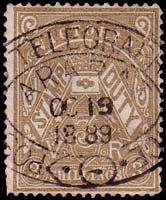 19 October 1889. (earliest recorded date). Provenance: Freeman, Johnstone. |
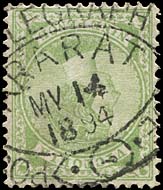 14 May 1894. (latest recorded date). Provenance: Max Watson, Johnstone. |
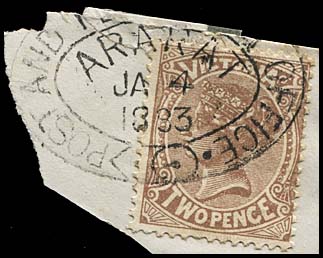 4 January 1893. |
||
|
 2 June 1891. |
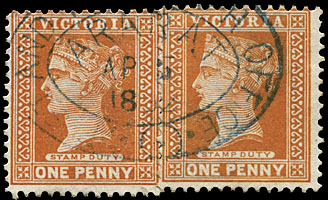 5 April 1892 (latest recorded date). |
3. The Telegraph Office was also issued with a circular rubber date stamp for ARARAT /TELEGRAPH SECTION.
|
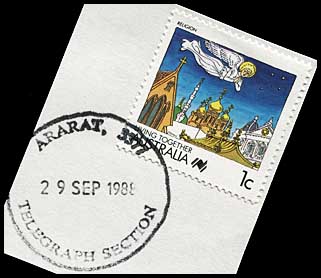 29 September 1988. |
|
| Beaufort.
We know not when the Telegraph Office opened at Beaufort. The Fiery Creek PO was renamed Fiery Creek P.G.F. on 1 January 1856. It was then renamed Raglan PO on 16 May 1860 then again renamed Beaufort PO on 27 May 1863. In March 1871, a tender was accepted from Wm. Seeley for the construction of a new Post and Telegraph Office at Beaufort for £1,149 19s. Now read the entry for Raglan below. |
|
| The office was issued with a 1 hole Belt & Buckle date stamp.
|
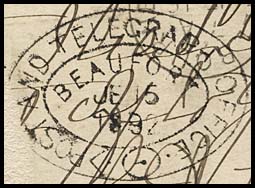 15 June 1892. Used on a Post Card to St Kilda. |
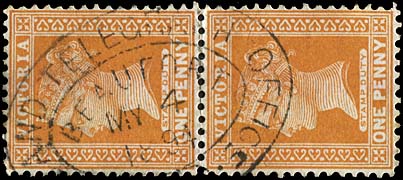 4 May 1894. |
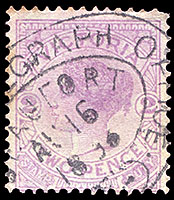 16 August 1896. Latest recorded date. |
|
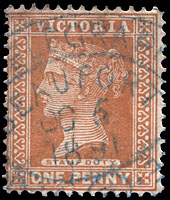 6 October 1891 (earliest recorded date in blue). |
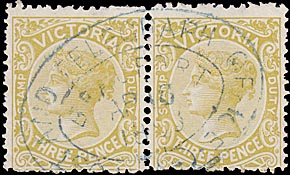 18 April 1893. |
One of only three recorded covers with a Belt & Buckle date stamp sent to an international destination. |
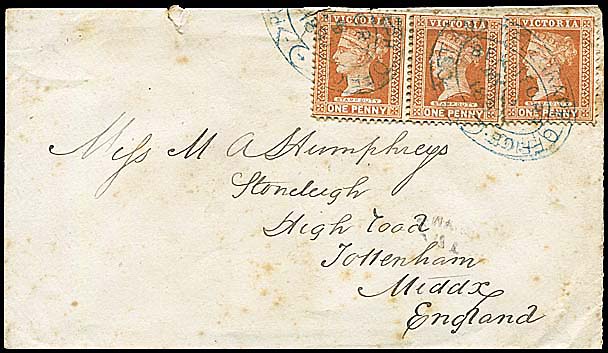 9 May 1892. |
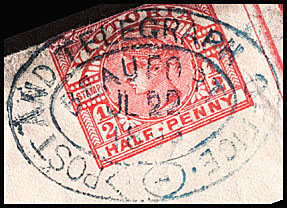 Detail of the B&B of 22 July 1893 on wrapper (see right). Latest recorded date in blue. |
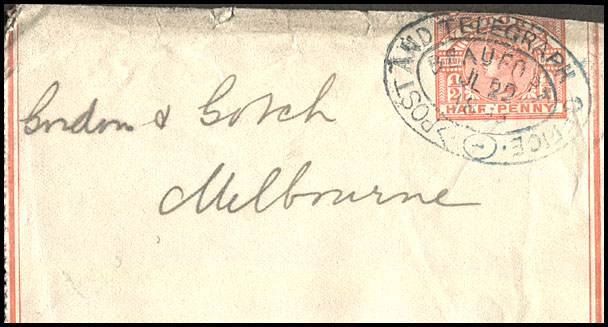 Part of the wrapper with the blue Belt & Buckle date stamp shown to the left. |
| Buangor. |
| Burrumbeet. |
|
The Telegraph Office opened in June 1880 in a wooden building together with the Post Office. "A banquet was held the evening on the 17th June at Dimboola to celebrate the connection of the town by telegraph with other centres of population". On 10 August 1882, telegraph facilities were also made available to the public at the railway station. The town was originally called Nine Creeks but changed name in 1863. The Post Office opened on 3 April 1863 as Nine Creeks but changed name to Dimboola in 1869. By 1883, the community was beginning to petition the Council and Assembly to fulfill a previous promise and erect a new P&T Office - and began some heated community discussion!!! In August 1884, tenders were called for the new Post and Telegraph Office - "which is urgently required". In mid-November 1884,, the Gazette announced that Mr. W. R. Cooper had won the tender to erect the new Post and Telegraph Office at Dimboola for £1,984 19s 6d. |
|
| In November 1885, Mr. James Kelly was transferred from Horsham (see below) to Dimboola to become Postmaster. |
The office was issued with a 1 hole Belt & Buckle date stamp.
|
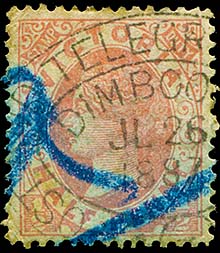 26 July 1887. Earliest recorded date. |
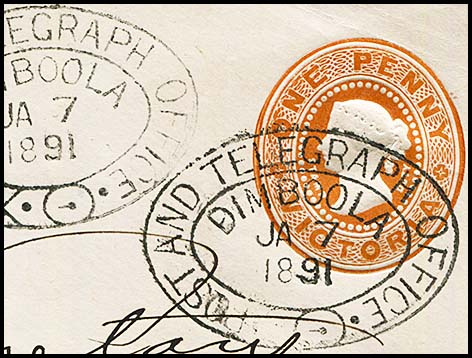 7 January 1891. |
|
|
|
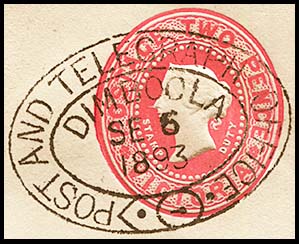 6 September 1893. Exceptionally strong strike. |
|
|
|
| In addition to the Belt & Buckle, Post Office date stamps were also used on telegrams. | 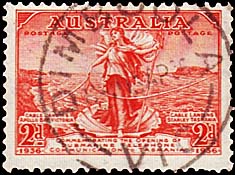 A usual Dimboola date stamp used in April 1936. |
|
The Telegraph Office was Gazetted on 14 September 1877 as having been opened. On 1 January 1879, a Telegraph Office was opened at the Railway Station. No special date stamps were used for telegrams. |
| Great Western.
Great Western is near Stawell. The Telegraph Office was opened about 1909 and it closed on 2 May 1910. The Post Office had been opened on 1 June 1858 and after the separate Telegraph Office closed, it was merged with the Post Office. A Telegraph Office operated at the Railway Station from 2 May 1910 to about 1916. |
||
| A T.O. Great Western date stamp may have been used in the first premises but is unrecorded.
It is known used in four formats - all with a diameter of 29 mm:
|
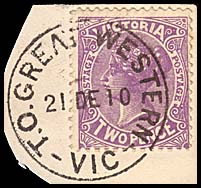 21 December 1910. |
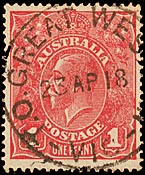 23 April 1918. |
|
||
|
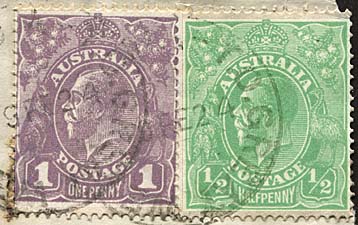 19 February 1924. |
|
|
.jpg) 10 July 1924. Earliest recorded date after inverted date line corrected. |
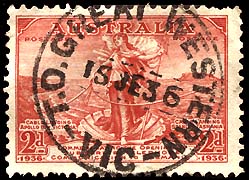 18 June 1936. |
|
||
T.O. Great Western date stamp on a commercial cover. Corrected date stamp showing gap between the year wheels.
|
|
|
| Horsham.
A Telegraph Office opened in temporary accommodation in January 1875. Mr. Kelly was appointed as Officer in Charge. The Post Office had opened on 1 July 1848. A lengthy article about Horsham and its Post and Telegraph Office from the Hamilton Spectator of 29 July 1874 is included elsewhere. The Australasian of 21 July 1877 reported that the Postmaster-General had met a deputation from Horsham "asking that a sum of £1,600 should be placed on the estimates to provide proper Post and Telegraph office accommodation at Horsham. Mr. Cuthbert said he would bring the application before his colleagues". Very soon after - on 1 April 1879 - the Hamilton Spectator reported on PUBLIC WORKS AT HORSHAM. In part, the article noted "The capital of the Wimmera appears to be basking in the sunshine of Ministerial favour and the inhabitants are in high feather at the large amounts now in process of disbursement for the improvement of the town. The Public Offices, the walls of which are now nearly complete, will be a spacious block of buildings, costing between £9,000 and £10,000. The plan is something like that of the Hamilton public offices but on a larger scale, the frontage being 73 feet by a depth of 52 feet. In addition to the rooms in the two storeys for the accommodation of the Post and Telegraph, survey, lands and receipt and pay departments, there is a battery room and other cool quarters underground, whilst a tall-clock-tower 70 feet high lifts its head for the purpose of telling the time of day". |
|
Personnel. On 31 October 1885, the Horsham Times noted :"The many friends of James Kelly, senior operator at the local Telegraph Office, will be pleased to learn that he has received a well deserved promotion, having been appointed Postmaster at Dimboola. During the many years that Mr. Kelly has been engaged in the Horsham office he has not only shown himself an apt operator but, by his obliging demeanour, has won the esteem of all with whom he has come in contact". On 6 December 1895, the Horsham Times carried the following article: "HORSHAM TELEGRAPH OFFICIALS IN PERIL. The break in the weather chronicled in the Times of Tuesday was followed by a couple of sultry and very unpleasant days. A little rain, but not by any means suffcient to clear the air, fell on Tuesday, and on Wednesday morning there was a short lived but, whilst it lasted, severe storm of thunder, lightning and wind. A very severe flash of lightning was experienced at the Horsham Post (and Telegraph) Office about half-past eight o'clock. The electricity entered the office and, being unable to get away in the ordinary course, fused the point of one of the arresters, burning off fully half an inch of the brass rod. It then travelled across the room and burst close to the back entrance door. Mr. Martin Dunne, the senior operator, and Mr. William Asquith, line repairer, had an extemely narrow escape from serious injury, if not from death. They reached the door of the operating room just as the electric current was finding its way out. Their first notice of what was going on was the sound of a violent explosion and they were next conscious that the electricity, in the form of a ball of fire, had exploded between them. They were naturally very much scared but fortunately sustained no injury. As a result of the electrical disturbance, the instruments in the office were disarranged for some considerable time". A Telegraph Office was also opened at the Horsham Railway Station about 1910. It closed in January 1965. |
| The office was issued with three types of date stamp for use with telegraphs:
|
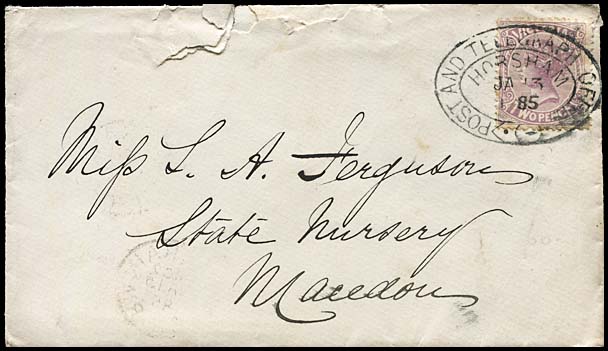 13 January 1885. |
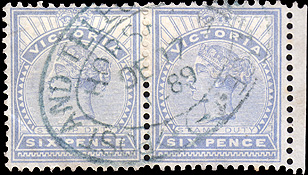 17 December 1889. Provenance: Hugh Freeman, Johnstone. |
|
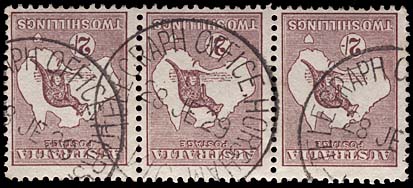 28 June 1929. |
|
 11 October 1941. Used on GCF-39C see below. |
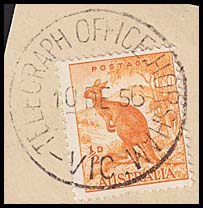 10 December 1956. |
|
|
||
|
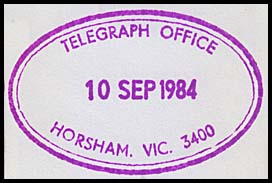 10 September 1984. |
| The usual Post Office date stamp was also used on telegrams. | 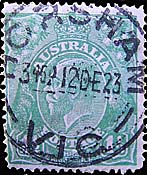 12 December 1923. |
|
The Telegraph Office was opened at the Railway Station in September 1879.. Jung Jung is just south-west of Murtoa. |
||
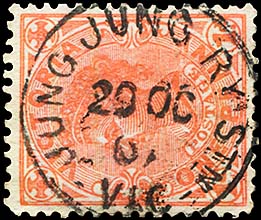 29 October 1901. |
||
| Kaniva.
The Telegraph Office opened in September 1882. |
||
A rubber rectangular TELEGRAPH OFFICE date stamp ams during the 1980s.
|
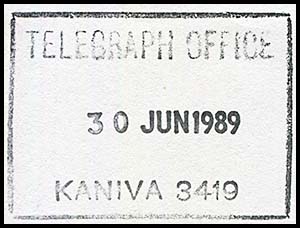 30 June 1989 (late usage - probably archival). |
|
| The usual postal date stamp was used on telegrams at Kaniva. | 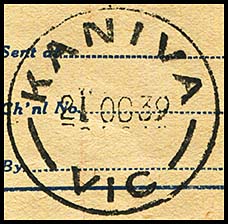 |
|
|
The Telegraph Office opened in May 1874. When the Postmaster-General had met a deputation in 1872, he imposed the following condition: On 5 May 1874, the Ballarat Star reflected the dissatisfaction of the Learmonth residents: "After a great deal of bungling, the telegraph posts and wires connecting Learmonth with other lines have at last been completed but, at present, are neither useful nor ornamental. Tenders were sent in some time ago for the necessary alterations at the Post Office, but not a word about them has been heard since. It is not the want, moreover, of an operator that has caused the long delay as a young lady was appointed months ago and has, during that time, been assisting at the Creswick office. Much dissatisfaction has been expressed by many residents of the district at the long delay and they naturally ask what's the matter. After the confidence reposed in the hon. member for Ripon and Hampden by the entire constituency, surely Mr Longmore might look in at the department and stir it up to immediate action. The line, I presume, will prove as great a convenience to the hon. Member as to his constituents, and it is hoped that he will be the first to shortly flash the news that the work is at last accomplished". No special date stamp was used at Learmonth for telegrams. |
|
|
| Murtoa.
The Telegraph Office opened at the Railway Station in December 1878 after tenders had been called in January 1878. A Telegraph Office was also opened in the Post Office in June 1880. There were few public buildings in Murtoa in 1880 - the Post and Telegraph Offices and the Court House were leased by the Government from Messrs. Anderson Brothers. The only decent structure belonging to the State was the schoolhouse built of brick in 1877.
|
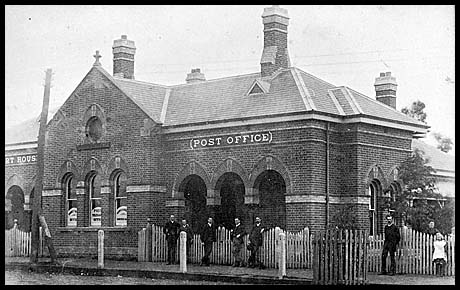 Murtoa Post & Telegraph Office 1880. The Court House can just be seen on the left. Source: State Library of Victoria 156398. |
|
A one hole Belt & Buckle date stamp was issued to the Murtoa office.
|
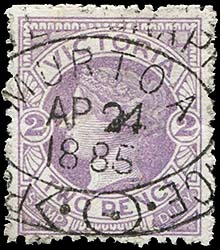 24 April 1885. |
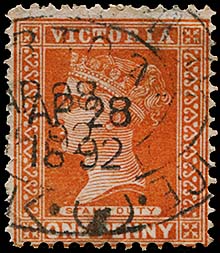 28 April 1892 (latest recorded date). |
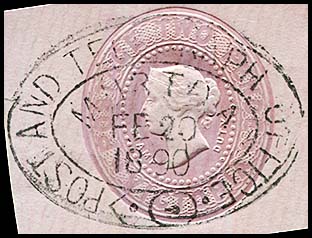 20 February 1890. Provenance: Hugh Freeman, Johnstone. |
||
| Nhill.
The Telegraph Office opened on 5 January 1882. A note later in the month noted: "From Deputy Postmaster-General: a telegraph office will be opened at Nhill, in charge of Miss Oliver; also that any other arrangement is not practicable at present". On 9 March 1888, the Colac Herald announced that Miss. Battern from the Nhill office would be replacing Mrs. Dawkins as the Post and Telegraph Office Mistress at Birregurra. The office was issued with two types of date stamps for use with telegraphic matters: |
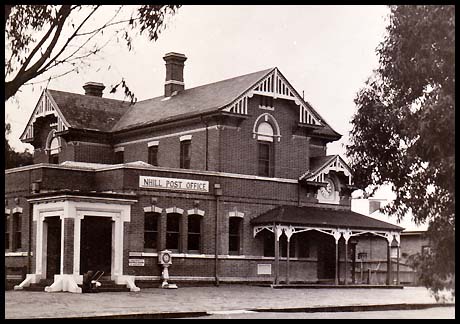 |
|
|
||
|
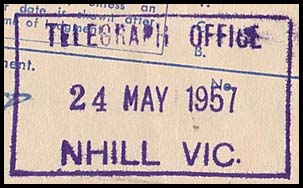 24 May 1957. Image by courtesy of Brian Sampson. |
|
| Ordinary Nhill postal date stamps used on telegrams. | 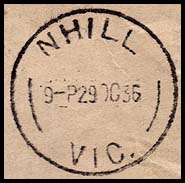 29 October 1935. Used for delivery of form AB-EO-7c. |
|
|
The Telegraph Office opened on 15 May 1858. It was located on the first line to South Australia and the first station after the line began at Ballarat. In 1864, the Raglan Telegraph Office expended £489 3s 6d on salaries, stores, maintenance etc. Its cash receipts were £97 2s 4d - giving a loss of £392 1s 2d (80%)!!!
The Raglan Post Office opened on 1 January 1865. |
|
| Stawell (Pleasant Creek). Bordertown line. The town was settled in the gold rush of 1853 and named Pleasant Creek. It was renamed Stawell in 1861. Telegraphic communication was established with Stawell in the first week of October 1861. It opened at Stawell although most references about that time continued the reference to Pleasant Creek. It is noted in the 1870 Report that, during 1870, Stawell Post Office was renamed Stawell West and Quartz Reef (Stawell) Post Office was renamed to Stawell. |
|
|
| On 1 October 1861, Charles Grattan Badge was appointed Operator in Charge of the new Telegraph Office at Stawell. An insight into life at Stawell is provided by part of a column in the Ballarat Star of 15 January 1869: "There is one matter which has astonished and disgusted our Ballarat visitors - to nearly as great an extent as we have been disgusted long ago — and that is the opposition of the three hotels, three stores and six dwelling-houses which, with the police camp, court-house, shire-hall, telegragh and post office, and receipt and pay-office, constitute the magnificent town of Stawcll. This wonderful place is a mile and a half away from the four or five thousand inhabitants at Reefs, and any one of the latter people has to go down there for a miner's-right, to get a summons or license, to get a money-order or to cash one, or to send a telegram. The consequence as regards the latter is that the telegraphic department does not receive from this place a fourth of the revenue it would for many persons prefer to write if they possibly can, rather than go through what is often a farce of sending or receiving a telegram. It is altogether monstrous that business should suffer in this way. As an instance—a gentleman was expecting a telegram and, after waiting for some time for it, had to leave and go elsewhere The messenger came to Reefs about seven o'clock but the person to whom the message was sent did not receive it till nearly a quarter to eight. There was no conveyance running and, although it was urgent that an answer should be sent that night, it could not go till next morning at eight o'clock and then entailed a walk of three miles. Among the requests recently urged on the Government was one for the establishment of a proper telegraph and post office with a delivery. The latter item is, of course of comparative unimportance, and, bring so, has been granted. But as far as one can see, telegraphing is as remote as ever. As the latest out, we are, it is stated, to lose our paymaster and receiver and the one from Ararat is to visit us occasionally to issue miner's-rights, etc. What the idea can be one cannot clearly see when remembering that Ararat has very little business and that here the officer is needed at least four days a week. Ararat is declining and its inhabitants — its lawyers and storekeepers — are coming to Reefs, which is making giant strides onwards". On 7 April 1869, The Ballarat Star reported that "Mr Johnson, Telegraph and Postmaster, Stawell, has resigned his appointment in consequence of it being intimated that he would be reduced a class in the Civil Service, by which means his salary would be cut down about one half. The Pleasant Creek journal says "Should such wholesale retrenchment be persevered with in the lower branches of the service, where most of the actual work of the department has to be performed and on whose officers a large amount of responsibility rests, we may shortly expect to hear of considerable disorganisation, if nothing worse, amongst the Government employees. The Postmaster at Ararat (Mr Murray) has, we understand, been treated in a somewhat similar manner and will shortly be removed to another station. In the latter named instance, the Government appear to have lost sight of the fact that this gentleman was invited from another colony at a time when experienced electricians were almost unobtainable in Victoria and has since rendered very important service." A Telegraph Office was also opened at the Railway Station about 1910 which closed about 1966. |
The office was issued with a 2 hole Belt & Buckle date stamp in 1890.
|
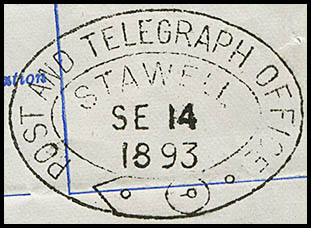 14 September 1893. Used on VC-DO-15A - see below. Note: 2nd hole not printed. |
| Top section of delivery form VC-DO-15A showing the use of the Belt & Buckle date stamp shown above in detail. |
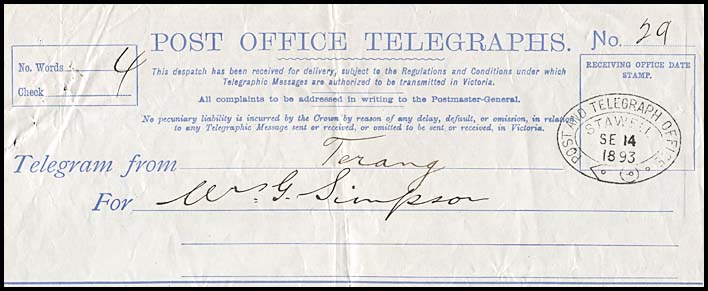 |
| Wabdallah. The Telegraph Office opened in May 1873. The Post Office was opened on No special date stamps were used for telegrams. |
|
The Telegraph Office
|
||
A T. O. date stamp was issued to the office.
|
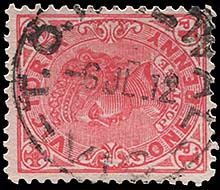 6 July 1912. |
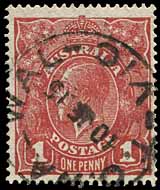 10 June 1915. |
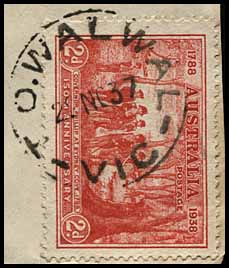 22 November 1937. |
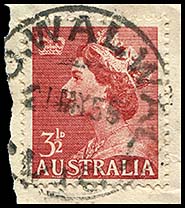 21 May 1955. |
|
Two formats for circular rubber TELEGRAPH SECTION date stamps were used at Warracknabeal:
|
|
|
|
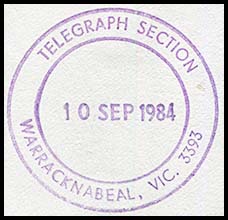 10 September 1984. |
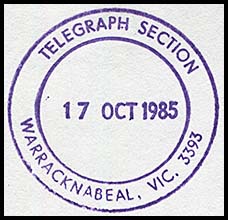 17 October 1985. |
Postal date stamps were also used on telegrams.
|
|
|
|
There is a complication here - there are two towns with telegraph offices in Victoria named Waterloo:
The Report for 1887 lists a Telegraph Office opening in conjunction with the Post Office at Waterloo. This Office was the one on the Bordertown line because a Post Office had been opened at Waterloo (Gippsland) in October 1878 and a Telegraph Office opened there in January 1880. The Gippsland Waterloo Office changed name on 20 December 1883 to Yarragon. |
| Windermere.
A Telegraph Office was opened at the Railway Station in March 1884. |
